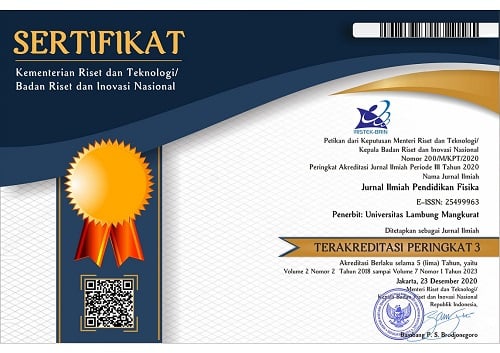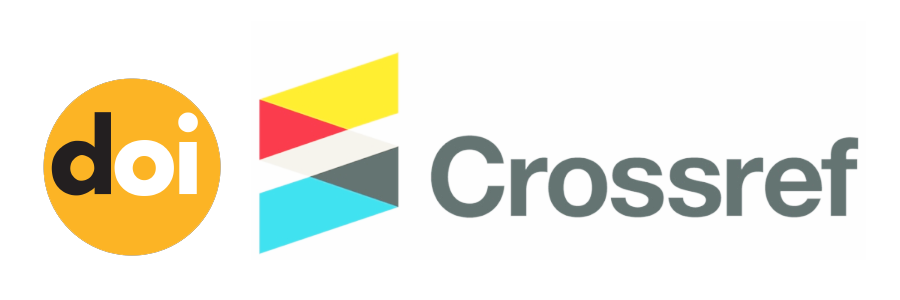Effectiveness of Using E-learning at STEM-based Physics Learning to Improve Communication Skills of High School Students
Abstract
This study aims to determine the effectiveness of e-learning in STEM-based physics instruction on students' communication abilities. This research is a continuation of development research using the Allesi and Trollip model, which three experts have validated to make STEM-based e-learning to improve students' communication skills feasibly. The pre-experimental pretest-posttest design was used in this study's methodology. Thirty-one students from class XI MIPA Senior High Schools made up the sample for this study. The instrument used is a communication skill observation sheet with three observers to compare the impact before-after intervention, this study employed SPSS 25 to conduct a t-test and n-Gain. The results of the t-test and n-gain calculations show that STEM-based physics learning e-learning can significantly improve students' communication skills with an average n-gain score of 0.62 in the medium category. The highest increase was in oral communication (n-gain: 0.74), and the lowest was in student presentation skills (n-gain: 0.51). Furthermore, given the value of the t-count<t-table is 29.75<1.70, the analysis utilizing the t-test yields H1 being accepted so that the developed e-learning can be used as a medium for learning physics in the revolutionary era 4.0 in order to be able to face the demands of 21st-century learning.
Keywords
Full Text:
PDFReferences
Allesi, S. M., & Trollip, S. R. (2001). Multimedia for learning methods and development (Third Edit).
Alyoussef, I. (2021). E-Learning system use during emergency: An empirical study during the covid-19 pandemic. Frontiers in Education, 6(June), 1–11. https://doi.org/10.3389/feduc.2021.677753
Arikunto, S. (2018). Dasar-dasar evaluasi pendidikan (R. Damayanti, Ed.; 3rd ed.). PT Bumi Aksara.
Azlan, C. A., Wong, J. H. D., Tan, L. K., Muhammad Shahrun, M. S. N., Ung, N. M., Pallath, V., Tan, C. P. L., Yeong, C. H., & Ng, K. H. (2020). Teaching and learning of postgraduate medical physics using Internet-based e-learning during the COVID-19 pandemic – A case study from Malaysia. Physica Medica, 80(July), 10–16. https://doi.org/10.1016/j.ejmp.2020.10.002
Bada, A. A., & Jita, L. C. (2021). E-learning facilities for teaching secondary school physics: awareness, availability and utilization. Research in Social Sciences and Technology, 6(3), 227–241. https://doi.org/10.46303/ressat.2021.40
Bao, L., & Koenig, K. (2019). Physics education research for 21st century learning. Disciplinary and Interdisciplinary Science Education Research, 1(1). https://doi.org/10.1186/s43031-019-0007-8
Batubara, I. H., Sari, I. P., Andini, P., Jannah, M., Saragih, S., Sinaga, B., Syahputra, E., & Lubis, B. S. (2022). Bibliometric mapping on the research “merdeka belajar” using vosviewer. Jurnal Pendidikan Progresif, 12(2), 477–486. https://doi.org/10.23960/jpp.v12.i2.202207
Elcullada Encarnacion, R., Galang, A. A., & Hallar, B. J. (2020). The impact and effectiveness of e-learning on teaching and learning. International Journal of Computing Sciences Research, 5(1), 383–397. https://doi.org/10.25147/ijcsr.2017.001.1.47
Fariyani, Q., & Kusuma, H. H. (2021). Development of test instruments to analyze higher-order thinking skills through science-based literacy learning. JIPF (Jurnal Ilmu Pendidikan Fisika), 6(1), 76. https://doi.org/10.26737/jipf.v6i1.1886
Hake, R. R. (1998). Interactive-engagement versus traditional methods: A six-thousand-student survey of mechanics test data for introductory physics courses. American Journal of Physics, 66(1), 64–74. https://doi.org/10.1119/1.18809
Hartanto, H., Marlina, L., & Wiyono, K. (2021). Pengembangan e-schoology materi getaran dan gelombang untuk meningkatkan keterampilan berpikir kritis siswa sekolah menengah pertama. Jurnal Ilmiah Pendidikan Fisika, 5(2), 211.
https://doi.org/10.20527/jipf.v5i2.3759
Haruna, N. A., Setiawan, D. G. E., & Odja, A. H. (2021). Penerapan e-learning menggunakan media edmodo dalam pembelajaran fisika berbasis nilai karakter untuk meningkatkan hasil belajar pada konsep usaha dan energi. Physics Education Research Journal, 3(1), 65–74. https://doi.org/10.21580/perj.2021.3.1.6737
Haryanti, A., & Suwarma, I. R. (2018). Profil keterampilan komunikasi siswa smp dalam pembelajaran ipa berbasis stem. WaPFi (Wahana Pendidikan Fisika), 3(1), 49. https://doi.org/10.17509/wapfi.v3i1.10940
Jufriadi, A., Rahayu, W. A., & Ayu, H. D. (2022). The effectiveness of hybrid guided inquiry for optimizing hots and communication skills in circular motion concepts. Jurnal Ilmiah Pendidikan Fisika, 6(2), 215–223. https://doi.org/https://doi.org/10.20527/jipf.v6i2.4134
Makiyah, Y. S., Mahmudah, I. R., Sulistyaningsih, D., & Susanti, D. E. (2021). Hubungan keterampilan komunikasi abad 21 dan keterampilan pemecahan masalah mahasiswa pendidikan fisika. JoTaLP: Journal of Teaching and Learning Physics, 6(1), 1–10.
Marfuah. (2017). Meningkatkan keterampilan komunikasi peserta didik melalui model pembelajaran Kooperatif Tipe Jigsaw. Jurnal Pendidikan Ilmu Sosial, 26(2), 148–160.
Marnita, M., Rahma, R., & Fatimah, F. (2021). Impact of e-learning media on students’ critical thinking skills at physics education study program, almuslim university. JIPF (Jurnal Ilmu Pendidikan Fisika), 6(2), 131. https://doi.org/10.26737/jipf.v6i2.1908
Maulida, N., Sa’adah, S., & Ukit, U. (2021). Peningkatan keterampilan berkomunikasi siswa melalui pembelajaran berorientasi tpack dengan blended learning pada materi sistem gerak. Jurnal BIOEDUIN: Jurnal Program Studi Pendidikan Biologi, 11(2), 79–87.
Mulyani, T. (2019). Pendekatan pembelajaran stem untuk menghadapi revolusi. Seminar Nasional Pascasarjana 2019, 7(1), 455.
Redhana, I. W. (2019). Mengembangkan keterampilan abad ke-21 dalam pembelajaran kimia. Jurnal Inovasi Pendidikan Kimia, 13(1).
Ridwan, M., Cholis, N., & Yulianti, D. (2020). Pembelajaran fisika berbasis science technology engineering and mathematics (stem) untuk mengembangkan keterampilan kolaborasi. Unnes Physics Education Journal, 9(3).
Septikasari, R., & Frasandy, R. (2018). Keterampilan 4c abad 21 dalam pembelajaran pendidikan dasar. Jurnal Tarbiyah Al Awlad, 8(2), 107–117.
Slavinec, M., Aberšek, B., Gačević, D., & Flogie, A. (2019). Monodisciplinarity in science versus transdisciplinarity in stem education. Journal of Baltic Science Education, 18(3), 435–449. https://doi.org/https://doi.org/10.33225/jbse/19.18.435
Sugiharni, G. A. D., & Setiasih, N. W. (2018). Validitas dan reliabilitas instrumen evaluasi blended learning matakuliah matematika diskrit di stikom bali berbasis model alkin. IndoMath: Indonesia Mathematics Education, 1(2), 93. https://doi.org/10.30738/indomath.v1i2.2626
Sukma, M., & Halim, A. (2022). Implementation of e-Learning Module Based on Science Technology Engineering Mathematics on Solar Cells Topic. 7(1), 60–70.
Sunarti, S., & Rusilowati, A. (2020). Pengembangan bahan ajar digital gerak melingkar berbantuan scratch berbasis science, technology, engineering, and mathematics. Unnes Physics Education Journal, 3(3), 77–83.
Sutriyono, S., & Wiyono, K. (2022). Efektivitas model blended learning berbasis media microsoft teams pada materi elastisitas untuk Meningkatkan Kemampuan Berpikir Kreatif Siswa.
Suwardi. (2021). Stem (Science, Technology, Engineering, and Mathematics) inovasi dalam pembelajaran vokasi era merdeka belajar abad 21. PAEDAGOGY : Jurnal Ilmu Pendidikan Dan Psikologi, 1(1), 40–48. https://doi.org/10.51878/paedagogy.v1i1.337
Syafei, I., Saregar, A., Hairul, Thahir, A., Sari, P. M., & Anugrah, A. (2020). E-learning with stem-based schoology on static fluid material. Journal of Physics: Conference Series, 1467(1). https://doi.org/10.1088/1742-6596/1467/1/012052
Taryono, T., Saepuzaman, D., Dhina, M. A., & Fitriyanti, N. (2019). Penerapan pembelajaran berbasis proyek dan pembelajaran berbasis masalah pada mata pelajaran fisika untuk meningkatkan keterampilan abad 21 (4cs) siswa smp. WaPFi (Wahana Pendidikan Fisika), 4(1), 89. https://doi.org/10.17509/wapfi.v4i1.15825
Umiyatun, U., Purnomo, M. E., & Indrawati, S. (2020). Moodle based worksheet on scientific article writing: A students perceptions. Jurnal Pendidikan Progresif, 10(1), 117–132. https://doi.org/10.23960/jpp.v10.i1.202013
Wahyuaji, N. R., & Suparman, S. (2018). Deskripsi kebutuhan media pembelajaran e-learning berpendekatan stem untuk mengembangkan kemampuan berpikir kritis dan kreatif siswa sma kelas xi. Seminar Nasional Pendidikan Matematik Ahmad Dahlan 2018, 6(1), 194–199.
Wahyudi, I. (2017). Pengembangan program pembelajaran fisika sma berbasis e-learning dengan schoology. Jurnal Ilmiah Pendidikan Fisika Al-Biruni, 6(2), 187–199. https://doi.org/10.24042/jipfalbiruni.v6i2.1850
Wahyuni, N. P. (2019). Penerapan model pembelajaran berbasis stem untuk meningkatkan hasil belajar ipa. Jurnal Pedagogi Dan Pembelajaran, 2(3), 377. https://doi.org/10.23887/jp2.v2i3.19293
Wati, D. S., Siahaan, S. M., & Wiyono, K. (2021). Efektivitas learning management system chamilo materi gerak harmonik sederhana terhadap hasil belajar peserta didik. LENSA (Lentera Sains): Jurnal Pendidikan IPA, 11(2), 100–109. https://doi.org/10.24929/lensa.v11i2.166
Widana, I. W., & Muliani, P. L. (2020). Uji persyaratan analisis. in teddy fiktorius (Ed.), Klik Media.
Wisnu Wibowo, I. G. A. (2018). Peningkatan keterampilan ilmiah peserta didik dalam pembelajaran fisika melalui penerapan pendekatan stem dan e-learning. Journal of Education Action Research, 2(4), 315. https://doi.org/10.23887/jear.v2i4.16321
Wiyono, K., Ismet, I., Noprianti, Permawati, H., Saparini, & Zakiyah, S. (2019). Interactive multimedia using multiple-intelligences-based in the lesson of thermodynamics for high school. Journal of Physics: Conference Series, 1166(1). https://doi.org/10.1088/1742-6596/1166/1/012014
Wiyono, K., Ismet, & Saparini. (2020). Development of interactive multimedia for learning physics based on traditional games. Journal of Physics: Conference Series, 1480(1). https://doi.org/10.1088/1742-6596/1480/1/012074
Wiyono, K., & Zakiyah, S. (2019). Pendidikan fisika pada era revolusi industri 4 . 0 di indonesia. Seminar Nasional Pendidikan Program Studi Pendidikan Fisika, 1(1), 1–14.
DOI: https://doi.org/10.20527/jipf.v6i3.5781
Refbacks
- There are currently no refbacks.
Indexed by: Jurnal Ilmiah Pendidikan Fisika is licensed under a creative commons attribution-share alike 4.0 international license
Statistics Counter |
















